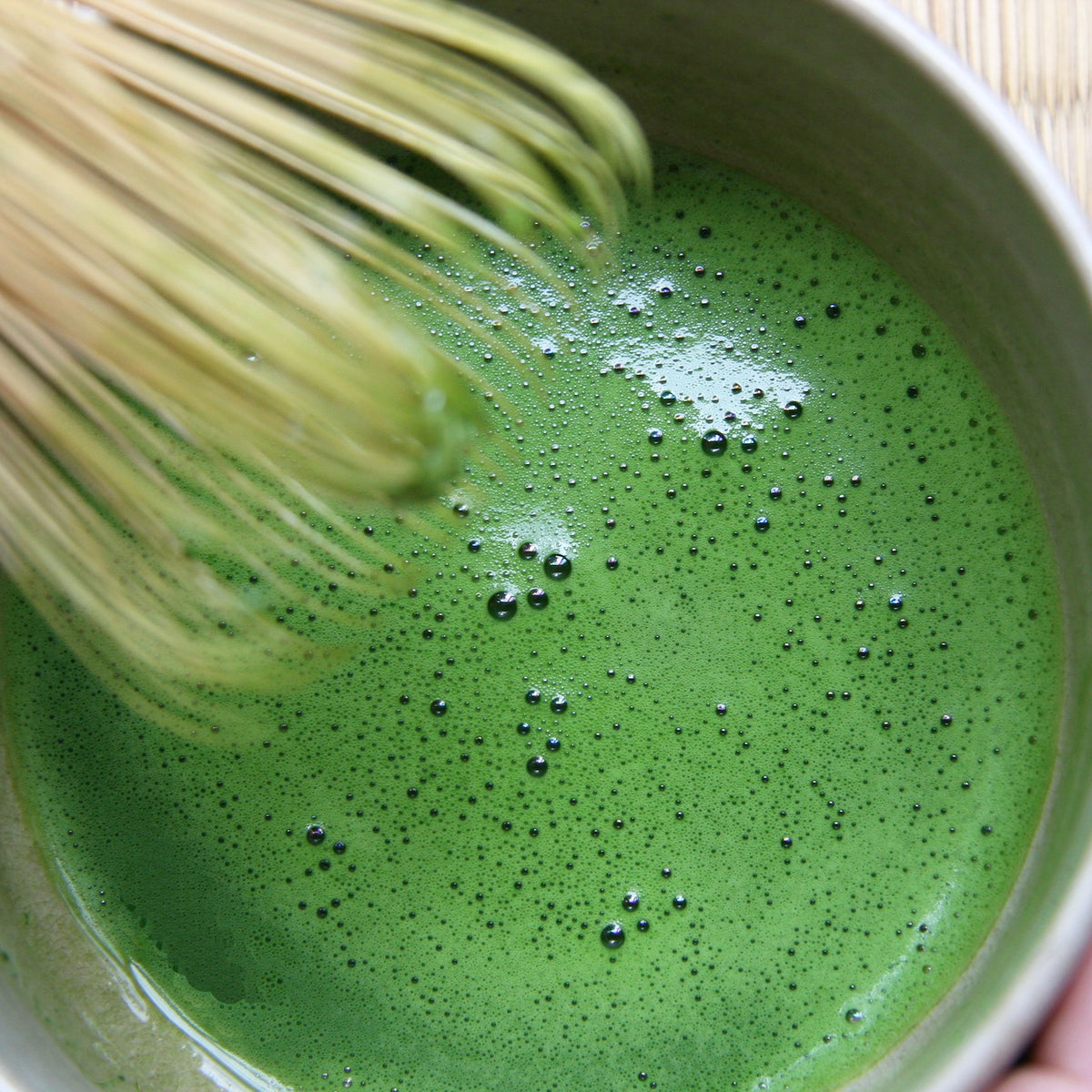ドイツでは、2012年頃からグルメブームとともに抹茶の消費量が増加し始めました。さらに、ここ4~5年はNetflixやテレビ番組がコーヒーへの関心を高め、やがて紅茶の人気も高まりました。温かいノンアルコール飲料といえば、ドイツはコーヒー文化圏と考えられており、濃厚なチョコレートケーキやアップルシュトゥルーデルと相性抜群です。しかし、ドイツには植物エキスを煎じる長い伝統があり、ヨーロッパ最大の薬用植物や香料植物の輸入、消費、加工国でもあります。
国際紅茶委員会(ITC)によると、 ドイツはヨーロッパ最大の紅茶輸入国であり、紅茶消費量は長年にわたり比較的安定しています。特に、ハンブルクに拠点を置くドイツ紅茶・ハーブティー協会は、2020年の紅茶消費量( カメリアシネンシス、ハーブティー、フルーツティーの両方)が2リットル増加し、一人当たり70リットルという過去最高を記録したと報告しています。さらに、業界専門家によると、ドイツでは依然として紅茶が最も人気のあるお茶ですが、緑茶の市場シェアは近年、 2013年の24.5%から2014年には29%へと大幅に増加しています(CBI、外務省)。近年、EU全体の緑茶輸入量は2020年から2021年にかけて635トンから835トンへと急増しました( 注:この急増はパンデミックの影響も一部あり、2022年には789トンに減少しています。農林水産省)。昨年、ドイツ茶協会が発表した茶の消費量に関する報告書では、抹茶が茶の中で最も急速に成長している分野であることが示されました。そこで私たちは、ドイツにおける抹茶の消費状況、抹茶がどのように利用されているか、そして誰が抹茶を飲食しているのかを調査しました。
アナ・スカルヤク氏はPaper & Tea GmbHのマネージャーを務めており、同社は 11 年前にベルリンで創業し、現在ではドイツ全土およびヨーロッパ各地に店舗を展開している、評判の高い老舗ティーショップです。アナ氏によると、ドイツには主に 2 つの抹茶消費者グループがいるようです。1 つ目は、彼女が「抹茶ピープル」と呼ぶ消費者です。この層は、お茶の「ウサギの穴」に落ちてしまった人たちです。アナ氏によると、こうしたお茶愛好家は最終的には日本茶に興味を持ち、当然抹茶に行き着くそうです。この傾向は、特に 1991 年のベルリンの壁崩壊後、およびおそらく国際文化への関心がコスモポリタン的に爆発的に高まったビジネスにおけるグローバルな役割を担うようになって以降の、ドイツのお茶消費の最近の歴史的傾向と似ています。
抹茶人気の高まりは、P&Tのような企業が効果的かつ戦略的に展開する教育セミナーやマーケティングによっても促進されています。アナはマーケティングは全く別の話題だと触れましたが、P&Tでは、良質の抹茶を味わうことと、抹茶を淹れる工程で適切な道具を使うこと(例えば、茶だまりを防ぐためのふるいなど)の重要性を強調しています。同社は、消費者に抹茶の淹れ方を教えるセミナーを提供することで、明らかに成功を収めています。アナはまた、教育教材において妥協点を見つけることの重要性を指摘しました。つまり、日本の伝統的な抹茶の儀式を尊重しつつも、形式や構造を過度に強調しないようにすることで、ヨーロッパの人々にとってより身近で親しみやすいものにしたいと考えているのです。このアプローチは、 Matcha Shop (2011年ベルリン創業)のオーナー、フロリアン・ロッシュ氏とサンドラ・ウェンツル氏にも反映されています。彼らはソーシャルメディアを活用し、飲み物としてだけでなく、抹茶の幅広い魅力を広め、より身近なものにしようとしています。茶碗で抹茶を点てるだけでなく、小さなバタークッキーを添えた抹茶ドリンクや、抹茶を振りかけたレモネード、サツマイモ入りの抹茶ブラウニーなど、独創的な抹茶レシピも披露されます。抹茶の楽しみ方に決まりはないのですから!
そして、抹茶に直接辿り着く2つ目の消費者グループがあります。健康志向の強い消費者で、健康やウェルネスの観点から抹茶に惹かれる人です。多くの欧米人が既にご存知かもしれませんが、抹茶は鮮やかな緑色でカテキンやビタミンを豊富に含むことから、海外ではスーパーフードとして認識されています。Matchashopのサンドラは、以前のインタビュー( Taste of Japan )で、 「抹茶には心をリフレッシュさせ、活力を与えて目覚めさせる効果があります。そのためか、医療関係者やヨガスクールなどから定期的にご注文をいただいています」と語っています。
健康志向の高まりから、抹茶はスピルリナのように粉末の錠剤として摂取されることもあります。また、抹茶は他の多くのスーパーフード成分と共に、パワースナックやヘルシースナックの代替品として使用されているようです。さらに、ドイツではビーガンや健康食品が大きなブームとなっており、抹茶は流行のビーガン/ベジタリアンレストランでも見つけることができます。多くの人が抹茶のビタミン、抗酸化物質、健康的なエネルギーブーストに惹かれ、抹茶スムージーや抹茶パウダードリンクを楽しんでいます。抹茶の代わりに、健康的ではない他の製品を飲む人もいます。例えば、ファストフード店でよく見かける一般的なソーダの代わりに、これらのヒップスターのたまり場であるCarpe Diem MatchaやBioZisch (抹茶フレーバー)などの抹茶炭酸飲料に出会うかもしれません。カルペディエム抹茶のオンライン説明には、 「抹茶に梨と生姜を加えると、舌だけでなく心も刺激され、最後の味覚芽まで抹茶茶のように踊り出すほど強烈です。あるいは、ただのお茶。全く、全く違います」とあります。
 ドイツで手に入る抹茶ドリンクをいくつかご紹介します。ベルリンに限りません。画像は、親切に調べてくれたドイツ、ライプツィヒの友人からいただいたものです。
ドイツで手に入る抹茶ドリンクをいくつかご紹介します。ベルリンに限りません。画像は、親切に調べてくれたドイツ、ライプツィヒの友人からいただいたものです。
カルペディエムの抹茶を飲みたくなりますか?ある情報提供者は、これらのボトル入り飲料は汚れた池の水に似ているとコメントしましたが、それが侮辱なのか褒め言葉なのかは不明です。注目すべきは、健康的な抹茶ブームの一部は、抹茶カフェや抹茶バーのある国際的でおしゃれな場所として知られるベルリンに集中している可能性があることです。たとえば、ベルリンの中心部にある初の抹茶専門カフェであるMatchasomeがあります。彼らが提供しているものには、健康的な(そして幸せな!幸せは抹茶の消費と彼らが結びつける重要なつながりのようです)抹茶ドリンクや自家製焼き抹茶ペストリーなどがあります。彼らの抹茶製品はすべて、鹿児島県の単一農園の有機茶園で収穫された、彼ら自身のセレモニーグレードの抹茶で作られていることは言うまでもありません。さらに、焼き菓子にも、一番茶のみを使用しています。
抹茶の消費量は今後数年間継続的に増加すると予想されており、ベルリンが例外ではなくトレンドを形成していることを示唆しています。抹茶の人気予測(世界市場で2022年から2030年の間に年平均10.9%で成長すると予測、EMERGEN Research)は、抹茶の消費と使用がヨーロッパ全体でまだ比較的一般的ではないという事実によるものですが、健康志向の消費者とお茶愛好家の両方からの関心が急速に高まり続けることが予想されます。興味深いことに、大津波と地震(2011年3月11日)の後、ドイツの消費者は放射能検査されていない日本茶を欲しがりませんでした。しかし、ヨーロッパと日本はどちらも食品の安全性検査に関しては非常に厳格であり、津波と原子力発電所のメルトダウンから10年以上が経過していることを考えると、消費者はもはや放射能検査をそれほど心配していないようです。ドイツ市場で入手可能な抹茶製品を調査した調査によると、過去5年間で165もの新製品が追加されており(MINTEL 2016)、その成長の大部分は近年に起きています。対照的に、2008年から2013年の間には、抹茶パウダーを使用した製品はわずか3つしかありませんでした。ドイツの主要都市をよく観察すると、消費者や店舗が抹茶ラテ、抹茶アフォガート(抹茶とアイスクリーム)、抹茶スムージー、インスタント抹茶ラテなどを試していることに気づくでしょう。また、カフェやベーカリーで抹茶ケーキが見られるという報告もあります。これらのデータから、抹茶のトレンドは今後も拡大していくことが示唆されており、同僚が抹茶ティラミスを持ってきてくれるという幸運に恵まれるかもしれません。
抹茶ティラミス!フランスに住んでいた頃、パン職人を目指して凝ったお菓子を焼いていた友人が、以前作った抹茶ティラミスが絶品だったと言っていました。そう、抹茶を使った焼き菓子はドイツだけでなく、ヨーロッパの多くの国で人気が高まっているんです。
熱心な抹茶愛飲家であるドイツ人たちは、日本文化への親近感が抹茶の魅力となっているものの、テロワール(土壌)に関してはそれほどこだわりがないようです。P&Tの同じ日本茶愛飲家たちがテロワールの茶葉にこだわっていることを考えると、これは意外なことです。それどころか、アナは、抹茶は日本全国どこでも構わないものの、彼らが求めているのは良質なもの(用途によって異なりますが、P&Tでは儀式用、日常用、料理用の抹茶を提供しています)であり、おそらく最も重要なのはオーガニックであることだと話しました。ドイツの茶会社の多くは、世界市場の大手茶会社(例えば、ヨーロッパへの日本茶最大の輸入業者であるAIYAなど)から抹茶を仕入れており、これらの会社は独自のブレンドを行っています。もちろん、よりお茶にこだわる消費者は、特定の地域、品種、生産者の抹茶をわざわざ探し求めるでしょうが、これは日本でも稀なことです。お茶を飲む一般の人々は、良質のオーガニック抹茶があれば満足し、あまり実験せずにそれを愛用しています。
興味深いことに、ドイツの消費者は伝統的な茶道をすべて行うわけではないものの、アナによると、彼女の知り合いの抹茶愛飲家は実際に独自の抹茶セットと擬似的な儀式を持っており、それには独自の茶筅、茶碗、茶托が含まれるとのことです。しかし、ここで違いが出てきます。ドイツで抹茶をいただく典型的な方法は、一般的に自宅での素早い朝の儀式です。抹茶を泡立て、エスプレッソショットのように数口ずつ飲みます。確かに、少数の人々にとっては、抹茶が朝のコーヒーに取って代わっているようです。朝の儀式で抹茶を愛飲する人々が、抹茶の穏やかな緑色を鑑賞したり、コーヒーとは異なる、抹茶で体験する禅のような覚醒状態を楽しんだりしている姿を想像したいと思います。いずれにせよ、何時間もかかる正式な儀式は、出勤前の5分間の時間にはあまり収まりきらないでしょう。
朝の抹茶タイム(お茶の時間と空間=茶の間)に、ゆっくりと時間をかけてじっくりと意識を向けるグループもあります。現在、抹茶は多くの人にとって自宅での手軽な朝のルーティンに留まっていますが、マインドフルネス(日記をつけたりお茶を飲んだりといったシンプルな活動に時間をかけること)のトレンドにより、ドイツの抹茶愛飲家は、抹茶を味わう時間を実際に取り、友人や同僚と分かち合うようになるかもしれません。P &Tのアナは次のように述べています。
人々はゆっくりと時間をかけて物事に取り組んでいます。スローライフという言葉がぴったりです。抹茶に関して言えば、これが私の未来のビジョンです。儀式的な方法で抹茶を点て、それを共有し、より深く伝統に根ざす試みが今後増えていくと思います。
 京都府宇治市の通園で心温まる抹茶のひとときを。
京都府宇治市の通園で心温まる抹茶のひとときを。
もしこの傾向が今後も続くようであれば、将来的にはドイツの抹茶消費者は、よりこだわりが強くなり、お茶にもっと熱中し、抹茶の産地にも興味を持つようになるかもしれません。どうなるか楽しみです!最後に、Yunomiの創設者であるイアン・チュン氏のコメントをご紹介します。イアン氏はドイツについてはあまり詳しくないと述べましたが、お茶愛好家はどんな背景を持つ人でも、世界中どこでも似たり寄ったりだと指摘しています。
[Q] ドイツの紅茶消費に関して、興味深い傾向や予想外の傾向はありましたか?また、ドイツ国内や国際市場の他の分野で何か変化が見られると予想されますか?
西洋全体で抹茶がフレーバーとしてより身近なものになるにつれ、焼き菓子や菓子類にますます取り入れられるようになると予想しています。また、抹茶ラテをメニューに加えるカフェも増えていくでしょう。これは基本的に、日本の市場における抹茶の利用法に倣うものになるでしょう。主な違いは、抹茶は茶道以外では一般的ではないのに対し、西洋では日常生活でより一般的に飲まれるようになることです。


